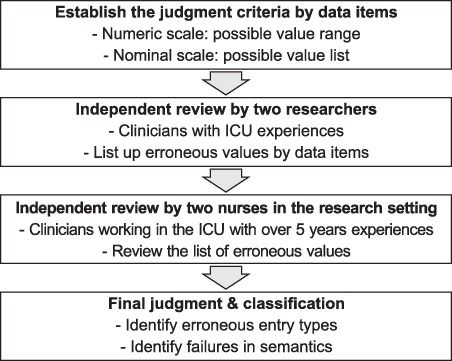J Korean Soc Med Inform.
2009 Dec;15(4):423-431.
Assessing the Quality of Structured Data Entry for the Secondary Use of Electronic Medical Records
- Affiliations
-
- 1Department of Nursing, School of Medicine, Inha University, Korea. insook.cho@inha.ac.kr
Abstract
OBJECTIVE
The raw material of quality improvement is information, whose building block is data. Data in an electronic medical record system have many secondary uses beyond their primary role in patient care, including research and organizational management. This study investigates the data quality of clinical observations recorded using a structured data entry format and assesses the impact of erroneous data. METHODS: A total of 4,580,846 input events from 3,348 inpatients, gathered over a three year period in a teaching hospital, were analyzed by using a 2-by-2 conceptual matrix framework for the appropriateness of data types and semantics. The data were classified into three categories: fully usable, partially usable, and not usable. RESULTS: The fully usable data constituted 88.6% of the correctly entered data the remaining 11.4% were erroneous. Among the erroneous data, 0.8% were partially usable (n=3,929), and the remaining 99.2% (n= 510,437) were identified as needing further assessment to improve their quality. CONCLUSION: Clinical information systems have increasingly used structured data entry or record templates, but the low quality of collected data has severely limited their secondary use potential.
MeSH Terms
Figure
Reference
-
1. Hogan WR, Wagner MM. Accuracy of data in computer-based patient records. J Am Med Inform Assoc. 1997. 4(5):342–355.
Article2. De Lusignan S. An educational intervention to improve data recording in the management of ischaemic heart disease in primary care. J Public Health. 2004. 26(1):34–37.
Article3. Brown C. Computer-based data collection boosts productivity, regulatory compliance. Nurs Manag. 2004. 35(2):40B-D.
Article4. Tang PC, McDonald CJ. Shortliffe EH, Cimino JJ, editors. Electronic Health Record Systems. Biomedical Informatics: computer applications in health care and biomedicine. 2006. 3rd ed. New York: Springer science and business media;447–475.
Article5. Fortinsky R, Gutman J. A two-phase study of the reliability of computerized morbidity data. J Fam Pract. 1981. 13:229–235.6. Thiru K. Systematic review of scope and quality of electronic patient record data in primary care. BMJ. 2003. 326(7398):1070.
Article7. Dresselhaus TR, Luck J, Peabody JW. The ethical problem of false positives: a prospective evaluation of physician reporting in the medical record. J Med Ethics. 2002. 28(5):291–294.
Article8. Shin AM, Park HJ, Jung SJ, Noh MJ, Kim YN. The paper-based medical record compared to the electronic medical record: documentation and agreement of information. J Korean Soc Med Inform. 2009. 15(2):201–208.
Article9. Vawdrey DK, Gardner RM, Evans RS, Orme JF Jr, Clemmer TP, Greenway L, et al. Assessing data quality in manual entry of ventilator settings. J Am Med Inform Assoc. 2007. 14(3):295–303.
Article10. Bloomrosen M, Detmer D. Advancing the framework: use of health data-a report of a working conference of the American medical informatics association. J Am Med Inform Assoc. 2008. 15(6):715–722.
Article11. Witten IH, Frank E. Data Mining: practical machine learning tools and techniques with Java implementations. 2000. San Francisco: Academic Press;48–56.12. Fayyad UM, Piatetsky-Shapiro G, Smyth P, Uthurusamy R. Advances in knowledge discovery and data mining. 1996. Califormia: American Association for Artificial Intelligence and MIT Press;48–51.13. Cho I, Yoon HY, Park SI, Lee HS. Availability of nursing data in an electronic nursing record system for a development of a risk assessment. J Korean Soc Med Inform. 2008. 14(2):161–168.
Article14. Lee KN, Yoon J, Choi Y, Cho H, Bae K, Yoon C, et al. Standardization of reference values among laboratories of Korean Association of Health Promotion. J Lab Med Qual Assur. 2002. 24:185–195.15. Kim J, Na Y, Yoon K, Lee H, Choo SK. Clinical chemistry. 2001. 3rd ed. Seoul: Korea Medicine Book Publisher;71–72.16. Lewis SM, Heitkemper MM, Dirksen SR, O'Brien PG, Giddens JF, Bucher L. Medical and surgical nursing. 2004. 6th ed. Missouri: Mosby;1758–1795.17. Stange K, Zyzanski S, Smith T, Kelly R, Langa D, Flocke S, et al. A comparison of US and Canadian family physician attitudes toward their respective health-care systems. Med Care. 1996. 34(8):837–844.
Article18. Dambro M, Weiss B. Assessing the quality of data entry in a computerized medical records system. J Med Syst. 1988. 12(3):181–187.
Article19. Ricketts D, Newey M, Patterson M, Hitchin D, Fowler S. Markers of data quality in computer audit: the Manchester Orthopaedic Database. Ann R Coll Surg Engl. 1993. 75(6):393–396.20. Porcheret M, Hughes R, Evans MD, Kordan K, Whitehurst R, Ogden H, et al. Data quality of general practice electronic health records: the impact of a program of assessments, feedback, and training. J Am Med Inform Assoc. 2004. 11(1):78–86.
Article
- Full Text Links
- Actions
-
Cited
- CITED
-
- Close
- Share
- Similar articles
-
- Use of clinical terminology for semantic interoperability of electronic health records
- Automated Reporting System Using Structured Data Entry: Application to Prostate US
- The Development of Medical Record Items: a User-centered, Bottom-up Approach
- Establishing semantic interoperability in the course of clinical document exchange using international standard for metadata registry
- Applications of Machine Learning Using Electronic Medical Records in Spine Surgery


